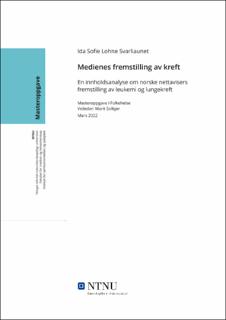| dc.contributor.advisor | Solbjør, Marit | |
| dc.contributor.author | Svarliaunet, Ida Sofie | |
| dc.date.accessioned | 2022-12-07T18:19:19Z | |
| dc.date.available | 2022-12-07T18:19:19Z | |
| dc.date.issued | 2022 | |
| dc.identifier | no.ntnu:inspera:96288842:6308015 | |
| dc.identifier.uri | https://hdl.handle.net/11250/3036609 | |
| dc.description.abstract | Vi lever i et samfunn hvor media er en stor del av hverdagen, og i en unik posisjon til å påvirke hvilke tema som fremmes i offentlig debatt. Måten sykdommer fremstilles på i media kan ha en innvirkning på den offentlige debatten, men også på befolkningens kunnskaper om bestemte sykdommer. Mange mennesker i Norge rammes hvert år av kreft. En gruppe norske sosiologer har studert sykdommers prestisje blant helsepersonell, og har identifisert en modell for sykdommers hierarki (Album, Johannessen & Rasmussen, 2017). Her var noen kreftsykdommer høyt rangert, mens andre var lavt rangert. I denne masteroppgaven har jeg gjort en studie der jeg undersøker hvordan de to kreftsykdommene med høyest og lavest prestisje i sykdomshierarkiet presenteres i norske nettaviser. Gjennom en induktiv innholdsanalyse har jeg undersøkt fremstillingen av leukemi og lungekreft i nettutgaven av VG, Aftenposten og Dagbladet i 2019. Datamaterialet bestod av totalt 90 artikler, 56 om leukemi og 34 om lungekreft. Gjennom en kvantitativ innholdsanalyse fant jeg at avisartiklene om lungekreft i stor grad formidler kreftforskning, i kontrast til i artiklene om leukemi. Blant artiklene om leukemi finner vi flere pasienthistorier enn blant artiklene om lungekreft, og vi ser at informasjon om leukemi formidles i forbindelse med pasienthistorier. Gjennom en kvalitativ innholdsanalyse fant jeg at det var tre hovedkategorier for innholdet i avisartiklene: et biomedisinsk perspektiv dominerer, samfunnsperspektivet og fortellinger om kreftpasienten. Felles for de to sykdommene er fokus på behandling, samfunnsøkonomiske vurderinger i forbindelse med behandling og pasientenes opplevelse av hastverk i møte med helsevesenet. Sentrale forskjeller mellom de to sykdommene omhandler en individualistisk fremstilling av risiko/forebygging, åpenhet/stigma og personifisering av sykdom. Den kvalitative analysen viste også at leukemi fremstilles som en sjelden sykdom og lungekreft som en vanlig sykdom, noe som stemmer overens med sykdommenes insidens i forhold til hverandre (Kreftregisteret, 2021), men står i kontrast til forskjellen i antall publiserte artikler mellom sykdommene. Faktorer som er antatt å påvirke sykdommers prestisje og som fremstilles ulikt i datamaterialet er blant annet risiko/årsak til kreftsykdom og pasientkarakteristikk. Denne studien indikerer at ulike kreftsykdommer fremstilles med noe ulike perspektiver i hvem/hva som er kilde til informasjon om sykdommene, hvilke pasienthistorier som trekkes frem og pasientkarakteristikk. | |
| dc.description.abstract | We live in a society where the media plays a major role in everyday life and is in a unique position to influence which topics are taken up for public debate. The way diseases are portrayed in the media can affects public debate but can also influence what knowledge people have about specific diseases. In Norway many people are affected by cancer each year. A group of Norwegian sociologists has studied the prestige accorded to different diseases by health care workers, and identified a disease hierarchy model (Album, Johannessen & Rasmussen, 2017). In this model some types of cancer were highly rated, and others lowly rated. In this master thesis I have researched how the types of cancer with highest and lowest prestige in the disease hierarchy model are presented in Norwegian online newspapers. By performing an inductive content analysis, I have researched how leukaemia and lung cancer are portrayed in the online editions of VG, Aftenposten and Dagbladet in 2019. The data consisted of 90 newspaper articles in total, 56 about leukaemia and 34 about lung cancer. A quantitative content analysis showed that more newspaper articles about lung cancer focused on cancer research, in contrast to the articles about leukaemia. The articles about leukaemia contain more patient narratives than the articles about lung cancer, and information about leukaemia is often conveyed in connection with patient narratives. Using a qualitative content analysis, I identified 3 main categories in the newspaper articles: the biomedical perspective dominates, the societal perspective and narratives about cancer patients. Common to both diseases were a focus on treatment, socio-economic assessments of treatment, and the urgency felt by patients in their interaction with the health care system. Key differences between the two diseases related to the degree of individualistic presentation of risk/prevention, openness versus stigma and personification of the disease. The qualitative analysis also showed that leukaemia was portrayed as a rare disease and lung cancer as a common disease, which is consistent with the incidence in relation to each other (Kreftregisteret, 2021), but contrasts with the difference in the number of published articles for each of the diseases. Factors that are assumed to affect the prestige of diseases and that are presented differently in the data are, among other things, risk/cause of cancer and patient characteristics. This study indicates that different cancer types are presented with somewhat different perspectives regarding who/what is the source of information about the disease, which patient narratives are highlighted and patient characteristics. | |
| dc.language | nob | |
| dc.publisher | NTNU | |
| dc.title | Medienes fremstilling av kreft | |
| dc.type | Master thesis | |
